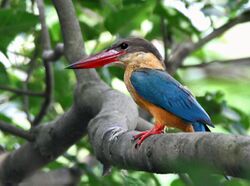Biology:Pelargopsis
- "Pelargopsis" was also invalidly given to Pelargopappus, a genus of fossil secretarybirds.
| Pelargopsis | |
|---|---|

| |
| Stork-billed kingfisher Pelargopsis capensis | |
| Scientific classification | |
| Domain: | Eukaryota |
| Kingdom: | Animalia |
| Phylum: | Chordata |
| Class: | Aves |
| Order: | Coraciiformes |
| Family: | Alcedinidae |
| Subfamily: | Halcyoninae |
| Genus: | Pelargopsis Gloger, 1841 |
| Type species | |
| Alcedo javana Boddaert, 1783
| |
| Species | |
|
See text | |
| Phylogeny | |||||||||||||||
| |||||||||||||||
| Cladogram based on Andersen et al. (2017)[1] |
Pelargopsis is a genus of tree kingfishers that are resident in tropical south Asia from India and Sri Lanka to Indonesia.
The genus was introduced by the German zoologist Constantin Gloger in 1841.[2] The type species is a subspecies of the stork-billed kingfisher Pelargopsis capensis javana.[3] The word Pelargopsis is derived from the classical Greek pelargos meaning "stork" and opsis meaning "appearance".[4]
The genus contains three species:[5]
| Image | Scientific name | Common name | Distribution |
|---|---|---|---|
 |
Pelargopsis capensis | Stork-billed kingfisher | Southeast Asia |
 |
Pelargopsis melanorhyncha | Great-billed kingfisher, black-billed kingfisher or Celebes stork-billed kingfisher | Sulawesi region of Indonesia |
 |
Pelargopsis amauroptera | Brown-winged kingfisher | Bangladesh, India, Malaysia, Myanmar and Thailand |
These three kingfishers were previously placed in the genus Halcyon.[6]
These are large kingfishers, 35 cm (14 in) in length.[6] They have very large red or black bills and bright red legs. The head and underparts of these species are white or buff, and the wings and back are darker, coloured variously in green and blue, brown or black depending on species. The sexes are similar. The flight of the Pelargopsis kingfishers is flapping, but direct.
Pelargopsis kingfishers inhabit a variety of well-wooded habitats near lakes, rivers, estuaries or coasts. They perch quietly whilst seeking food, and are often inconspicuous despite their size. They are territorial and will chase away eagles and other large predators. These species hunts crabs, fish, frogs, and in the case of stork-billed at least, rodents and young birds.
Pelargopsis kingfishers excavate their nests in a river bank, decaying tree, or a tree termite nest and lay round white eggs.
References
- ↑ Andersen, M.J.; McCullough, J.M.; Mauck III, W.M.; Smith, B.T.; Moyle, R.G. (2017). "A phylogeny of kingfishers reveals an Indomalayan origin and elevated rates of diversification on oceanic islands". Journal of Biogeography 45 (2): 1–13. doi:10.1111/jbi.13139.
- ↑ Gloger, Constantin Wilhelm Lambert (1842) (in de). Gemeinnütziges Hand- und Hilfsbuch der Naturgeschichte. 1. Breslau: A. Schulz. p. 338. https://www.biodiversitylibrary.org/page/13515648. The title page is dated 1842.
- ↑ Peters, James Lee, ed (1945). Check-list of Birds of the World. 5. Cambridge, Massachusetts: Harvard University Press. p. 186. https://www.biodiversitylibrary.org/page/14480197.
- ↑ Jobling, James A. (2010). The Helm Dictionary of Scientific Bird Names. London: Christopher Helm. p. 295. ISBN 978-1-4081-2501-4. https://archive.org/details/Helm_Dictionary_of_Scientific_Bird_Names_by_James_A._Jobling.
- ↑ Gill, Frank; Donsker, David, eds (2017). "Rollers, ground rollers & kingfishers". World Bird List Version 7.2. International Ornithologists' Union. http://www.worldbirdnames.org/bow/rollers/.
- ↑ 6.0 6.1 Fry, Fry & Harris 1992, pp. 137-141.
Sources
- Fry, C. Hilary; Fry, Kathie; Harris, Alan (1992). Kingfishers, Bee-eaters, and Rollers. London: Christopher Helm. ISBN 978-0-7136-8028-7.
Wikidata ☰ Q383275 entry
 |

